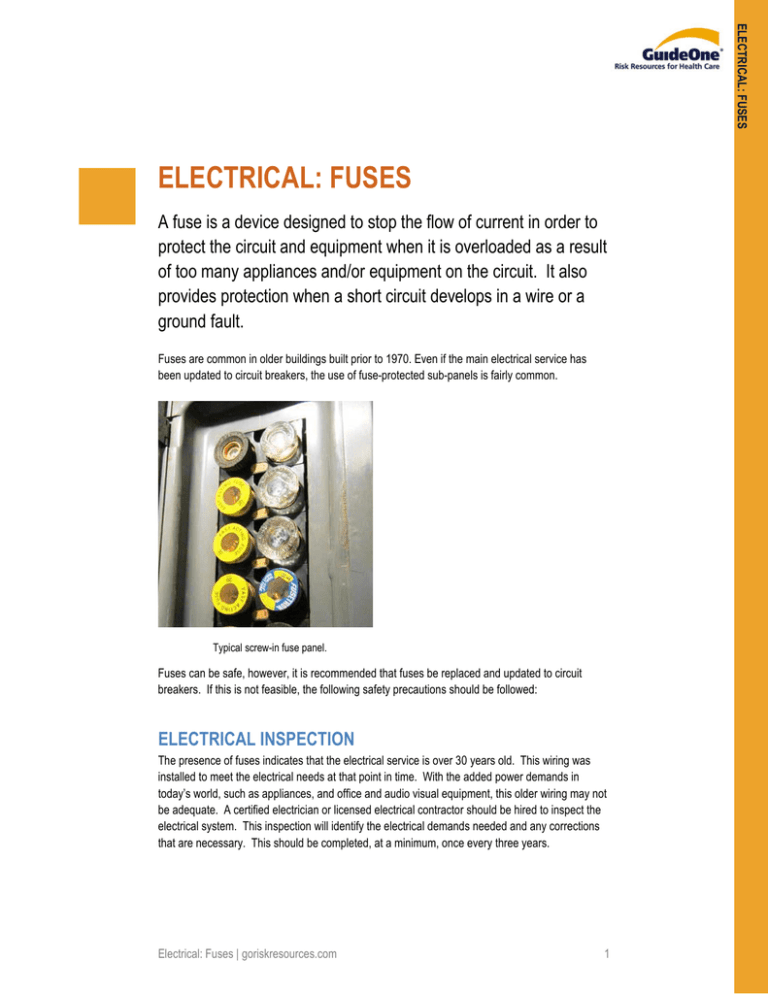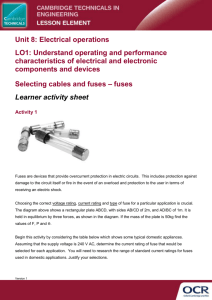
ELECTRICAL: FUSES
ELECTRICAL: FUSES
A fuse is a device designed to stop the flow of current in order to
protect the circuit and equipment when it is overloaded as a result
of too many appliances and/or equipment on the circuit. It also
provides protection when a short circuit develops in a wire or a
ground fault.
Fuses are common in older buildings built prior to 1970. Even if the main electrical service has
been updated to circuit breakers, the use of fuse-protected sub-panels is fairly common.
Typical screw-in fuse panel.
Fuses can be safe, however, it is recommended that fuses be replaced and updated to circuit
breakers. If this is not feasible, the following safety precautions should be followed:
ELECTRICAL INSPECTION
The presence of fuses indicates that the electrical service is over 30 years old. This wiring was
installed to meet the electrical needs at that point in time. With the added power demands in
today’s world, such as appliances, and office and audio visual equipment, this older wiring may not
be adequate. A certified electrician or licensed electrical contractor should be hired to inspect the
electrical system. This inspection will identify the electrical demands needed and any corrections
that are necessary. This should be completed, at a minimum, once every three years.
Electrical: Fuses | goriskresources.com
1
TAMPER PROOF FUSES
More often than not, a blown fuse is the result of an overloaded circuit. This means that there is
too much electrical demand on the circuit. If the fuse is continually blowing, there is a much more
serious problem, and a certified electrician or licensed electrical contractor should be hired to
correct the problem.
However, an all too common practice to stop a fuse from continually blowing is to install a higherrated fuse in the circuit. For example, replacing a 15-amp fuse with a 20-amp fuse. This is a
recipe for disaster, as this allows for more current into the circuit than it was designed for, which
can lead to overheating of the wire and probable fire.
To prevent mismatching or over fusing of the circuit, Fustat® fuses – also called type “S” tamperproof fuses – should be installed for all screw-in fuse panels. These come in different amperage
sizes, and each tamper-proof fuse will only screw into the correct tamper-proof base. This will
prevent installing a higher-rated amp fuse into a lower amp-rated circuit.
Fustat® fuses, (also called type S) as shown in the
image above, are not interchangeable, meaning you
cannot install a 20-amp fuse into a 15-amp base. The
base adapter on the right screws into any fuse socket
Screw the Fustat® into the base adapter (as shown above),
and then screw the combined assembly into the socket on
your electrical panel. The next time you unscrew this fuse, its
base adapter will stay in place and will only accept the
Fustat® fuse in the correct amp rating
FAKE FUSES
The ability to insert copper/metal tubes (fake fuses) with cartridge-style fuses is an extremely
dangerous situation, since this does not provide over current protection. If the circuit is not
protected, you are increasing the potential for a fire to occur, arcing and electrical shock. If a fuse
has to be replaced, always install properly matched fuses. If the fuse is continually blowing, as
earlier discussed, this is an indication of a more serious problem and should be corrected by a
certified electrician or licensed electrical contractor.
This image shows a piece of metal tube that was inserted
in the middle circuit. This is being used as a conductor
and was most likely installed because the existing fuse
kept blowing. This practice should never be done.
2
goriskresources.com | Electrical: Fuses
A renewable fuse is a cartridge-style fuse. If the fuse is blown, the cap is unscrewed, and the link
can be replaced, allowing the fuse to be reused. Once the link has been replaced, the mechanical
connection between the link and the fuse cap can become loose, dirty, corroded or otherwise
faulty, resulting in a connection that can generate heat in the hundreds of degrees and cause the
insulation on the conductor to deteriorate. Once the conductor makes contact with the metal of the
panel or the conduit, a short circuit occurs, which can result in arcing and fire. Renewable fuses
should not be used and should be replaced with one-time use standard fuses.
A renewable fuse is a cartridge style fuse that can be identified by labeling (image
on left) and/or by the end caps that can be unscrewed (image on right)
This image shows a renewable fuse and its components. The element is inserted into
slots on the top and bottom of the fuse, and the threaded caps screw on and apply
pressure to the element. (Photo courtesy of Hartford Steam Boiler)
Electrical: Fuses | goriskresources.com
3
ELECTRICAL: FUSES
RENEWABLE FUSES
FUSE CLIP CLAMPS
Fuse clip clamps – also known as torpedo or depth charge clamps – were originally used on
submarines and some warships in World War II. Their purpose was to prevent fuses from coming
out of the clips during depth charges or other explosions. Today, these are used in some older
buildings in an attempt to compress the clip to the fuse blade. This is an indication that the clamp
does not have enough compression to make solid contact with the fuse cartridge blade, which can
lead to resistance to current flow. This makes the clamp and blade elevate in temperature, and
can lead to fire. These clip clamps should not be used and a certified electrician or licensed
electrical contractor should be hired to replace the clips.
© 2012 GuideOne Risk
Resources for Health Care, a
division of Lutheran Trust, Asset
Management.
All rights reserved.
This image shows a clip clamp being used to eliminate the heating that was actually being caused by high
resistance connections inside the fuse. The real problem is the clips do not have enough compression
and should be replaced (Photo courtesy of Hartford Steam Boiler).
The presence of fuses in the electrical system indicates older wiring, and every attempt should
be made to replace fuses with circuit breakers. If this is not financially feasible, and the above
mentioned guidelines are followed, your chances of an electrical loss from fuses will be reduced.
This material is for informational
purposes only. It is not intended
to give specific legal or risk
management advice, nor are any
suggested checklists or actions
plans intended to include or
address all possible risk
management exposures or
solutions.
You are encouraged
to consult with your own
attorney or other expert
consultants for a
professional opinion
specific to your situation.
GuideOne Risk Resources for
Health Care
1111 Ashworth Road
West Des Moines, Iowa 50265
1-800-688-3628
4
goriskresources.com | Electrical: Fuses


